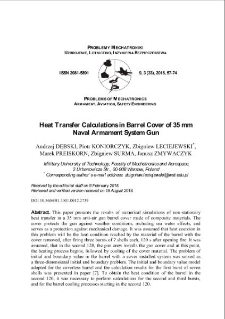Nasza Biblioteka Cyfrowa udostępnia 1 868 obiektów cyfrowych
Obiekt
Tytuł: Heat Transfer Calculations in Barrel Cover of 35 mm Naval Armament System Gun ; Heat Transfer Calculations in Barrel Cover of 35 mm Naval Armament System Gun
Tytuł odmienny:
Obliczenia wymiany ciepła w osłonie lufy 35 mm armaty Okrętowego Systemu Uzbrojenia ; Obliczenia wymiany ciepła w osłonie lufy 35 mm armaty Okrętowego Systemu Uzbrojenia
Współtwórca:
Piotr KONIORCZYK, Zbigniew LECIEJEWSKI, Marek PREISKORN, Zbigniew SURMA, Janusz ZMYWACZYK ; Piotr KONIORCZYK, Zbigniew LECIEJEWSKI, Marek PREISKORN, Zbigniew SURMA, Janusz ZMYWACZYK
Abstrakt:
This paper presents the results of numerical simulations of non-stationary heat transfer in a 35 mm anti-air gun barrel cover made of composite materials. The cover protects the gun against weather conditions, including sea water effects, and serves as a protection against mechanical damage. It was assumed that heat coercion in this problem will be the heat condition reached by the material of the barrel with the cover removed, after firing three bursts of 7 shells each, 120 s after opening fire. It was assumed, that in the second 120, the gun crew installs the gun cover and at this point, the heating process begins, followed by cooling of the cover material. The problem of initial and boundary value in the barrel with a cover installed system was solved as a three-dimensional initial and boundary problem. The initial and boundary value model adopted for the coverless barrel and the calculation results for the first burst of seven shells was presented in paper [7]. To obtain the heat condition of the barrel in the second 120, it was necessary to perform calculations for the second and third bursts, and for the barrel cooling processes starting in the second 120. The calculations were performed with a finite element method in the COSMOS/M software [9]. The cover material temperature values obtained during the numerical simulation are well below the temperature of 387K, which could form the upper limit of the composite applicability temperature range.
;
This paper presents the results of numerical simulations of non-stationary heat transfer in a 35 mm anti-air gun barrel cover made of composite materials. The cover protects the gun against weather conditions, including sea water effects, and serves as a protection against mechanical damage. It was assumed that heat coercion in this problem will be the heat condition reached by the material of the barrel with the cover removed, after firing three bursts of 7 shells each, 120 s after opening fire. It was assumed, that in the second 120, the gun crew installs the gun cover and at this point, the heating process begins, followed by cooling of the cover material. The problem of initial and boundary value in the barrel with a cover installed system was solved as a three-dimensional initial and boundary problem. The initial and boundary value model adopted for the coverless barrel and the calculation results for the first burst of seven shells was presented in paper [7]. To obtain the heat condition of the barrel in the second 120, it was necessary to perform calculations for the second and third bursts, and for the barrel cooling processes starting in the second 120. The calculations were performed with a finite element method in the COSMOS/M software [9]. The cover material temperature values obtained during the numerical simulation are well below the temperature of 387K, which could form the upper limit of the composite applicability temperature range.
Miejsce wydania:
Warszawa
;
Warszawa
Wydawca:
Wojskowa Akademia Techniczna ; Wojskowa Akademia Techniczna
Data utworzenia:
Data złożenia:
Data wydania:
Rozmiar:
Identyfikator:
oai:ribes-88.man.poznan.pl:2517
Sygnatura:
DOI 10.5604/01.3001.0012.2739 ; DOI 10.5604/01.3001.0012.2739
ISSN elektroniczny:
ISSN drukowany:
Język:
Właściciel praw:
Wojskowa Akademia Techniczna ; Wojskowa Akademia Techniczna
Strona początkowa:
Strona końcowa:
Tom:
Słowa kluczowe:
mechanics, heat transfer, anti-aircraft gun barrel cover ; mechanics, heat transfer, anti-aircraft gun barrel cover
Kolekcje, do których przypisany jest obiekt:
Data ostatniej modyfikacji:
18 wrz 2025
Data dodania obiektu:
18 wrz 2025
Liczba wyświetleń treści obiektu:
0
Wszystkie dostępne wersje tego obiektu:
https://ribes-88.man.poznan.pl/publication/2825
Wyświetl opis w formacie RDF:
Wyświetl opis w formacie OAI-PMH:
| Nazwa wydania | Data |
|---|---|
| Heat Transfer Calculations in Barrel Cover of 35 mm Naval Armament System Gun | 18 wrz 2025 |
Obiekty Podobne
Andrzej DĘBSKI Tomasz MAJEWSKI, Robert PASZKOWSKI

